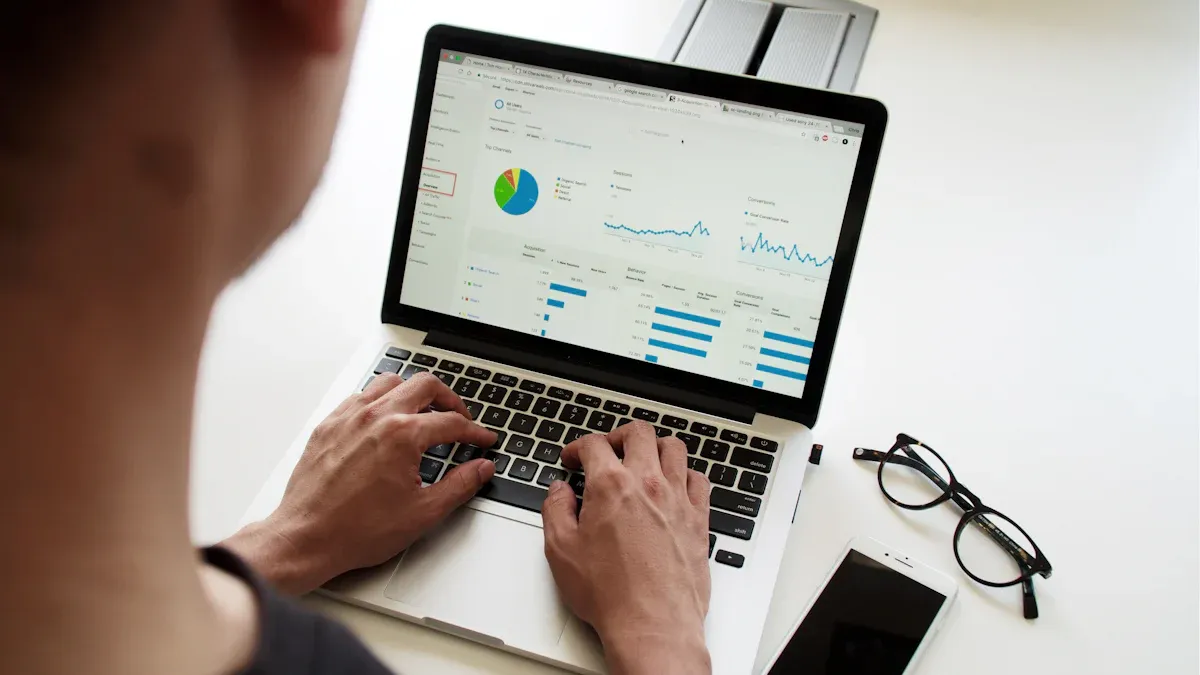Understanding the HR Tech Stack and Its Key Components

An HR tech stack is a collection of integrated tools and software that simplifies human resource processes. These tools work together to automate repetitive tasks, reduce errors, and provide valuable insights for better decision-making.
Companies that ensure seamless integration of their HR tools often report successful implementations, which leads to improved operational efficiency.
The growing reliance on HR technology reflects its importance.
In the past year, 12.1 million employers in the U.S. invested over $5 trillion in HR technology, showing a strong shift toward digital transformation.
74% of companies plan to increase their HR technology budgets, emphasizing the need for enhanced HR functionalities.
By adopting the right tools, you can streamline operations and focus on strategic goals like improving employee experience. This makes understanding the HR Tech Stack: What Should Your Company Invest In? a critical step for modern HR management.
Key Takeaways
An HR tech stack makes HR tasks easier and faster. It also helps avoid mistakes, so HR can focus on big goals.
Using good HR tools improves how employees feel at work. This makes them happier and stay longer in their jobs.
HR tech stacks give useful data to make smart choices. This helps match HR plans with company goals.
Checking and updating your HR tech stack often keeps it useful. It also helps it fit new business needs.
Pick tools that work well together and are easy to use. This helps more people use them and work better.
Why an HR Tech Stack Is Important

Streamlining HR Processes
An HR tech stack simplifies and automates repetitive tasks, allowing you to focus on strategic priorities. Tools like HRIS and payroll management systems reduce the time spent on administrative work. This efficiency translates into measurable improvements:
Metric | Improvement Percentage |
|---|---|
HR Process Efficiency | 40% |
Time Spent on Administrative Tasks | 30% |
By integrating these tools, you can eliminate manual errors and ensure consistency across HR operations. A well-integrated tech stack also enables seamless workflows, making it easier to manage employee data, track performance, and handle compliance requirements.
A simplified HR process not only saves time but also empowers HR teams to contribute to broader organizational goals.
Enhancing Employee Experience
Your employees benefit directly from an optimized HR tech stack. Automated onboarding systems, for example, create a smoother transition for new hires, reducing turnover rates. Research shows that organizations using productivity-enhancing tools see 158% higher employee engagement. Employees are also 61% more likely to stay with companies that invest in such technologies.
Seamless integration of HR tools ensures a cohesive experience for employees. From accessing benefits information to participating in performance reviews, these tools make processes more intuitive. This optimization fosters a positive workplace culture and enhances overall satisfaction.
By prioritizing employee experience, you not only retain talent but also boost morale and productivity.
Supporting Data-Driven Decision Making
An HR tech stack provides valuable insights that guide your decisions. Analytics tools within the stack help you track key metrics like employee turnover, engagement, and performance. This data enables you to identify trends and address issues proactively.
Metric | Improvement Percentage |
|---|---|
Informed Decision-Making | 60% |
HR Process Efficiency | 40% |
Employee Satisfaction | 35% |

With data-driven insights, you can align HR strategies with business goals. This approach ensures that your decisions are not only informed but also impactful.
Leveraging data empowers you to create a more agile and responsive HR function.
Improving Compliance and Risk Management
Compliance and risk management are critical for any organization. An HR tech stack helps you stay ahead by automating compliance tasks and reducing human error. These tools ensure that your company adheres to labor laws, tax regulations, and industry standards.
Tip: Non-compliance can lead to hefty fines and damage your reputation. Investing in the right tools protects your business.
HR software simplifies compliance by keeping all employee records in one place. This centralization makes it easier to track important details like work hours, certifications, and contract renewals. You can also set up automated alerts to remind you of upcoming deadlines or policy changes.
Key benefits of using an HR tech stack for compliance include:
Accurate Record-Keeping: Digital tools store and organize data securely, reducing the risk of errors.
Policy Updates: Automated systems notify you of changes in labor laws or tax codes.
Audit Readiness: Comprehensive reports ensure you are always prepared for audits.
Compliance Feature | Benefit |
|---|---|
Automated Alerts | Prevent missed deadlines |
Centralized Documentation | Simplify audits and inspections |
Real-Time Updates | Stay informed about new laws |
Risk management also improves with the right tools. For example, you can use analytics to identify trends that may lead to workplace issues. Early detection allows you to address problems before they escalate. Additionally, secure platforms protect sensitive employee data from breaches.
By leveraging technology, you minimize risks and maintain a safe, compliant workplace. This proactive approach saves time and resources while building trust with employees and stakeholders.
A well-optimized HR tech stack ensures compliance and reduces risks, giving you peace of mind to focus on growing your business.
HR Tech Stack: What Should Your Company Invest In?
HRIS (Human Resource Information System)
Core functionalities of an HRIS
An HRIS serves as the backbone of your HR tech stack. It centralizes employee data, automates HR processes, and ensures compliance with labor laws. Key functionalities include:
Employee Data Management: Store and organize employee records securely.
Payroll Integration: Automate salary calculations and tax deductions.
Compliance Tracking: Stay updated on labor laws and regulations.
Self-Service Portals: Allow employees to access their information and update details.
Benefits of using an HRIS
Investing in an HRIS can transform your HR operations. By automating repetitive tasks, you free up time for strategic initiatives. For example, a company reduced payroll processing time by 50% and saved 15 hours of administrative work weekly. Additionally, an HRIS improves decision-making by providing real-time data insights. This leads to better workforce planning and higher employee satisfaction.
Applicant Tracking Systems (ATS)
Role of ATS in recruitment
An ATS streamlines your hiring process by automating tasks like resume screening and interview scheduling. Nearly 99% of Fortune 500 companies use ATS to manage recruitment. These systems reduce time-to-hire by up to 60%, helping you secure top talent faster. Dell Technologies, for instance, reported a 25% reduction in hiring time after refining their ATS.
Features to look for in an ATS
When choosing an ATS, prioritize features that enhance efficiency:
Resume Parsing: Automatically extract key details from resumes.
Candidate Tracking: Monitor applicants throughout the hiring process.
Analytics and Reporting: Evaluate hiring strategies with data-driven insights.
Integration Capabilities: Ensure compatibility with other HR tools.
Payroll and Benefits Management Tools
Automating payroll processes
Payroll tools simplify salary calculations, tax filings, and compliance tracking. Automating these tasks reduces errors and saves time. For example, Daffy’s retail chain cut payroll processing time from hours to minutes, saving $15,000 annually. These tools also ensure timely payments, boosting employee trust and satisfaction.
Managing employee benefits effectively
Benefits management tools help you offer competitive packages while reducing administrative burdens. Companies using comprehensive benefits software see a 22% improvement in employee retention rates. These tools also provide self-service portals, allowing employees to explore and manage their benefits easily. This fosters transparency and enhances the employee experience.

Learning and Development Platforms
Importance of employee training tools
Investing in employee training tools is essential for fostering growth and retaining top talent. These platforms empower your workforce to develop new skills, stay updated with industry trends, and advance their careers. Employees value professional development opportunities, with 94% stating they would stay longer at companies that invest in their growth. Organizations with strong learning cultures also see a 30-50% increase in retention rates.
A robust learning and development (L&D) platform enhances loyalty and career progression. It creates a culture where employees feel supported and motivated to excel. By prioritizing training, you not only improve individual performance but also strengthen your organization's overall capabilities.
Features of effective L&D platforms
When selecting an L&D platform, focus on features that promote accessibility and engagement:
Personalized Learning Paths: Tailor training programs to individual needs and career goals.
Mobile Accessibility: Enable employees to learn anytime, anywhere.
Gamification: Use rewards and challenges to make learning interactive and enjoyable.
Analytics and Reporting: Track progress and measure the impact of training initiatives.
Statistic | Description |
|---|---|
94% | Employees who would stay longer if their professional development is supported. |
30-50% | Increase in employee retention rates in companies with strong learning cultures. |
Performance Management Systems
Tracking employee performance
Performance management systems (PMS) help you monitor and evaluate employee contributions effectively. These tools provide real-time data, enabling you to identify high performers and address areas for improvement. Continuous feedback fosters learning and adjustment, making performance management an integral part of daily operations. Accurate data also supports decisions on promotions and compensation, ensuring fairness and transparency.
Regular acknowledgment of achievements boosts morale and engagement.
Aligning individual goals with organizational objectives creates a motivated workforce.
Facilitating feedback and reviews
Modern PMS emphasize ongoing feedback rather than annual reviews. Companies like General Electric and Adobe have shifted to continuous feedback models, improving communication and trust between managers and teams. Regular feedback clarifies expectations and helps employees stay aligned with company goals.
Company | Approach to Performance Management |
|---|---|
General Electric | Continuous feedback and development, moving away from traditional annual reviews. |
Adobe | Implemented the 'Check-In' system focusing on regular feedback and coaching instead of annual reviews. |
Employee Engagement Tools
Promoting workplace culture
Employee engagement tools play a vital role in building a positive workplace culture. These tools encourage open communication, collaboration, and recognition. For example, Google’s Project Aristotle revealed that teams with psychological safety outperform peers by up to 25% in productivity. Regular pulse surveys also lead to a 30% increase in retention rates.
Organizations with strong feedback cultures experience 14.9% lower turnover rates. By fostering engagement, you create an environment where employees feel valued and motivated to contribute their best.
Measuring employee satisfaction
Measuring satisfaction is crucial for understanding employee needs and improving their experience. Engagement tools provide insights through surveys, feedback mechanisms, and analytics. Companies with highly engaged workforces report 21% higher profitability and 17% greater productivity.

By leveraging these tools, you can identify areas for improvement and implement strategies to enhance satisfaction. This approach not only boosts morale but also drives organizational success.
How to Build or Optimize an HR Tech Stack

Assessing Current Needs and Gaps
Start by evaluating your current HR processes to identify areas that need improvement. Conducting an internal audit can help you pinpoint gaps in training programs, employee development, and resource allocation. For example, XYZ Tech’s audit revealed misaligned training initiatives and skill gaps, leading to actionable recommendations that improved their workforce capabilities.
Use these insights to align your HR tech stack with your business objectives. Focus on areas like recruitment, compliance, and employee engagement. Regular assessments ensure your tools remain effective and adaptable to changing needs.
Tip: Involve your HR team in the evaluation process. Their firsthand experience provides valuable input for identifying inefficiencies and opportunities for optimization.
Prioritizing Integration and Scalability
Integration and scalability are critical for building a future-proof HR tech stack. Seamless integration ensures your tools work together as a cohesive ecosystem, enhancing efficiency across departments. Successful companies often collaborate with finance, marketing, and operations teams to ensure compatibility between tools.
Scalability allows your tech stack to grow with your organization. A rapidly expanding startup, for instance, benefited from selecting an HRIS designed to adapt to evolving needs. This approach avoids future inefficiencies and ensures smooth expansion.
Set aside part of your budget for unexpected developments, such as compliance changes or business growth.
Choose scalable solutions that align with your long-term goals.
View your HR tech stack as an interconnected system rather than isolated tools.
Failing to prioritize scalability can lead to increased costs and inefficiencies down the line.
Ensuring User-Friendly Interfaces
User-friendly interfaces are essential for maximizing adoption rates and satisfaction. HR software should be simple, effective, and enjoyable to use. Poor usability often results in low success rates, where users struggle to complete tasks, leading to frustration.
Key usability metrics include success rate, error rate, and time taken to complete tasks. Measuring user satisfaction on a scale of 1-5 provides valuable insights into how employees feel about the software.
Note: A well-designed interface reduces errors and saves time, empowering your team to focus on strategic initiatives.
Focus on intuitive navigation and clear design elements. Tools with strong user experience (UX) foster higher engagement and productivity, ensuring your HR tech stack delivers maximum value.
Evaluating Vendor Support and Security
Vendor support and security play a critical role in the success of your HR tech stack. When selecting a vendor, you must evaluate their ability to provide ongoing assistance and ensure robust security measures. A reliable vendor offers timely support, helping you resolve technical issues quickly and minimizing disruptions to your operations.
Strong security measures are essential to protect sensitive HR data. Look for solutions that include encryption, compliance with regulations like GDPR and CCPA, and robust access controls. These features safeguard your data and reduce the risk of breaches. Additionally, tools with end-to-end audit trails provide verifiable records, ensuring transparency and accountability.
Tip: Evaluate the security of each integration in your tech stack. Properly configured integrations prevent data leaks and keep your systems organized.
When assessing vendors, consider the following:
Ensure their solutions integrate seamlessly with your existing tools. This enhances user experience and workflow flexibility.
Verify that their security standards align with industry best practices. Built-in safeguards should protect your data throughout all processes.
Assess their responsiveness and ability to adapt to your evolving needs. A proactive vendor ensures your tech stack remains effective over time.
By prioritizing vendor support and security, you create a foundation for a reliable and efficient HR tech stack.
Regularly Reviewing and Updating the Stack
Regular reviews and updates are vital for maintaining the performance of your HR tech stack. Start by listing all the technologies you currently use. Categorize them based on their functions and calculate the total costs, including direct and indirect expenses. This helps you understand the financial impact of your tools.
Gather feedback from your team to identify features that may be cumbersome or underutilized. Usage metrics can also reveal which tools deliver the most value. Analyze this data to pinpoint areas for improvement and eliminate redundant features.
Note: Collaborate with other departments to identify synergies and ensure your tools align with broader business objectives.
To keep your stack optimized, follow these steps:
Review vendor performance regularly. Ensure they provide adequate support and stay updated with industry trends.
Conduct compliance checks to ensure your tools meet the latest regulations.
Update your stack to address gaps and incorporate new technologies that enhance efficiency.
By reviewing and updating your HR tech stack, you ensure it remains aligned with your goals and continues to deliver maximum value.
An HR tech stack plays a vital role in modern HR management. It simplifies processes, enhances employee satisfaction, and supports data-driven strategies. By investing in the right tools, you can create a more efficient and agile HR function.
A well-optimized stack delivers measurable outcomes. For example:
Outcome Type | Measurable Impact |
|---|---|
Revenue Performance | Teams with higher engagement scores generate 20-25% higher revenue per employee. |
Customer Satisfaction | Teams with retention rates above industry averages maintain customer satisfaction scores 15% higher. |
Innovation Outcomes | Investments in employee development translate to market advantages through improved innovation metrics. |
To maintain your stack, review it regularly and update tools to meet evolving needs. Focus on integration, scalability, and user-friendly designs. These steps ensure your HR tech stack continues to drive success for your organization.
FAQ
What is an HR tech stack?
An HR tech stack is a collection of software tools that work together to manage HR tasks. These tools streamline processes like recruitment, payroll, and employee engagement. They improve efficiency and help you make better decisions using data.
How do I choose the right tools for my HR tech stack?
Start by identifying your company’s needs. Look for tools that integrate well with existing systems. Prioritize scalability and user-friendly interfaces. Evaluate vendor support and security features to ensure long-term reliability.
Can small businesses benefit from an HR tech stack?
Yes, small businesses can benefit greatly. An HR tech stack automates repetitive tasks, saving time and reducing errors. It also helps you stay compliant with regulations and improves employee satisfaction, even with limited resources.
How often should I update my HR tech stack?
Review your HR tech stack at least once a year. Regular updates ensure your tools remain effective and compliant with new regulations. Gather feedback from your team to identify gaps and make necessary improvements.
Are HR tech stacks expensive to implement?
Costs vary depending on the tools you choose. Many vendors offer scalable solutions for different budgets. Start with essential tools like HRIS or payroll software. Gradually expand your stack as your company grows.
See Also
Revolutionizing HR Functions Using MokaHR's Management Software
Finding Top HR Software Solutions Available Online
Boosting Productivity Through MokaHR's HR Management Tools
Improving Employee Satisfaction with MokaHR's Talent Solutions
From recruiting candidates to onboarding new team members, MokaHR gives your company everything you need to be great at hiring.
Subscribe for more information

